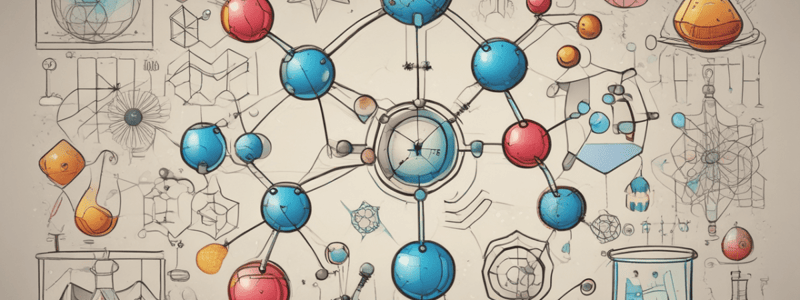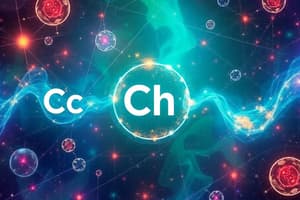Podcast
Questions and Answers
What is the study of the composition and characteristics of matter, and the changes that it can undergo?
What is the study of the composition and characteristics of matter, and the changes that it can undergo?
chemistry
What is the study of how the human body functions?
What is the study of how the human body functions?
human physiology
What do the foods you eat and the air you breathe provide to your cells?
What do the foods you eat and the air you breathe provide to your cells?
nutrients and oxygen
What is true about chemicals in food?
What is true about chemicals in food?
What is the focus of Section 4.2 in the chapter?
What is the focus of Section 4.2 in the chapter?
What system is discussed in Section 4.3 of the chapter?
What system is discussed in Section 4.3 of the chapter?
What types of health problems are covered in Section 4.4 of the chapter?
What types of health problems are covered in Section 4.4 of the chapter?
What are you, according to the chapter, a complex collection of?
What are you, according to the chapter, a complex collection of?
What are the two types of particles found in the nucleus of an atom?
What are the two types of particles found in the nucleus of an atom?
What is the definition of an element in chemistry?
What is the definition of an element in chemistry?
What is the symbol for sodium in chemistry?
What is the symbol for sodium in chemistry?
What is the term for the attraction that holds atoms together in a molecule?
What is the term for the attraction that holds atoms together in a molecule?
What is the chemical formula for a water molecule?
What is the chemical formula for a water molecule?
How many bonding sites does each carbon atom have?
How many bonding sites does each carbon atom have?
What is the term for compounds that contain carbon?
What is the term for compounds that contain carbon?
What is the chemical formula for the simple sugar glucose?
What is the chemical formula for the simple sugar glucose?
What is the primary component of solutions in living things?
What is the primary component of solutions in living things?
What is the definition of solubility?
What is the definition of solubility?
What happens to an atom when it gains or loses one or more electrons?
What happens to an atom when it gains or loses one or more electrons?
What is the formula for the positively charged hydrogen ion?
What is the formula for the positively charged hydrogen ion?
What is the function of electrolytes in the body?
What is the function of electrolytes in the body?
What is the definition of an acid?
What is the definition of an acid?
What is the range of the pH scale?
What is the range of the pH scale?
What is the difference between a solute and a solvent?
What is the difference between a solute and a solvent?
What is the pH of a neutral solution, and why is it considered neutral?
What is the pH of a neutral solution, and why is it considered neutral?
What happens to the pH of a solution as it becomes more basic or alkaline?
What happens to the pH of a solution as it becomes more basic or alkaline?
Compare the acidity of tomatoes and black coffee based on their pH values.
Compare the acidity of tomatoes and black coffee based on their pH values.
What is the purpose of buffers in the blood?
What is the purpose of buffers in the blood?
How do the lungs help maintain the normal pH of blood?
How do the lungs help maintain the normal pH of blood?
What is the function of kidneys in the buffering system?
What is the function of kidneys in the buffering system?
What is the characteristic of anthocyanin in solutions with a pH of less than 4?
What is the characteristic of anthocyanin in solutions with a pH of less than 4?
What type of chemical reaction involves the breaking down of molecules?
What type of chemical reaction involves the breaking down of molecules?
What is the result of the reaction between vinegar and baking soda?
What is the result of the reaction between vinegar and baking soda?
What is the role of enzymes in living organisms?
What is the role of enzymes in living organisms?
What is the difference between anabolic and catabolic reactions?
What is the difference between anabolic and catabolic reactions?
What is the purpose of including an acid ingredient in recipes that require baking soda?
What is the purpose of including an acid ingredient in recipes that require baking soda?
What is the effect of heating on enzymes?
What is the effect of heating on enzymes?
What is the result of combining certain fruits, such as pineapple, with gelatin?
What is the result of combining certain fruits, such as pineapple, with gelatin?
What is the characteristic of enzymes that makes them specific to certain reactions?
What is the characteristic of enzymes that makes them specific to certain reactions?
What are the factors that can alter an enzyme's activity?
What are the factors that can alter an enzyme's activity?
Flashcards are hidden until you start studying
Study Notes
Basic Chemistry Concepts
- Matter is composed of atoms that contain certain particles, including protons and electrons.
- Atoms are the building blocks of matter, and there are over 100 different types of atoms, each with its own unique properties.
- Elements are substances that cannot be separated into simpler substances by ordinary chemical or physical means.
- Examples of elements essential for human nutrition include hydrogen, oxygen, carbon, nitrogen, calcium, phosphorus, potassium, sulfur, sodium, chloride, magnesium, iron, iodine, copper, zinc, manganese, cobalt, chromium, and selenium.
Atoms to Compounds
- Atoms interact and form chemical bonds, which hold them together and form molecules.
- Chemical bonds can be single, double, or triple bonds, depending on the number of electrons shared between atoms.
- Molecules can contain the same element or different elements, and are represented by chemical formulas (e.g. O2, H2O, C6H12O6).
Solutions
- A solution is an evenly distributed mixture of two or more compounds, where one compound is the solvent (primary component) and the other is the solute (substance that dissolves).
- Examples of solutions include sports drinks, fruit juice, and blood plasma.
- Solubility is the ability of a substance to dissolve in a solvent.
Ions
- Ions are atoms or groups of atoms that have gained or lost electrons, resulting in a positive or negative electrical charge.
- Examples of ions include sodium (Na+), potassium (K+), and chloride (Cl-).
- Ions are important in the body, as they help maintain proper fluid balance and nerve function.
Acids and Bases
- Acids are substances that lose H+ ions when dissolved in water.
- Bases are substances that accept H+ ions when dissolved in water.
- The pH scale measures the concentration of H+ ions in a solution, ranging from 0-14, with 7 being neutral.
- Examples of acidic substances include citric acid, vinegar, and stomach acid, while examples of basic substances include baking soda, soap, and bleach.
Chemical Reactions
- Chemical reactions involve the changes in the arrangement of atoms in molecules.
- There are two main types of chemical reactions: synthetic reactions, where elements or compounds combine to form new substances, and decomposition reactions, where molecules break down into simpler substances.
- Enzymes are biological molecules (usually proteins) that catalyze specific chemical reactions.
Enzymes
- Enzymes speed up chemical reactions, allowing them to occur at a faster rate.
- Each enzyme has a specific action and is sensitive to environmental conditions such as pH, temperature, and the presence of certain vitamins and minerals.
- Enzymes are essential for metabolism, the sum of all chemical reactions that occur in living cells.
Metabolism
- Metabolism involves both catabolic reactions, which break down molecules, and anabolic reactions, which synthesize new compounds.
- Enzymes play a crucial role in metabolism, allowing the body to maintain homeostasis and perform various functions.
Studying That Suits You
Use AI to generate personalized quizzes and flashcards to suit your learning preferences.




